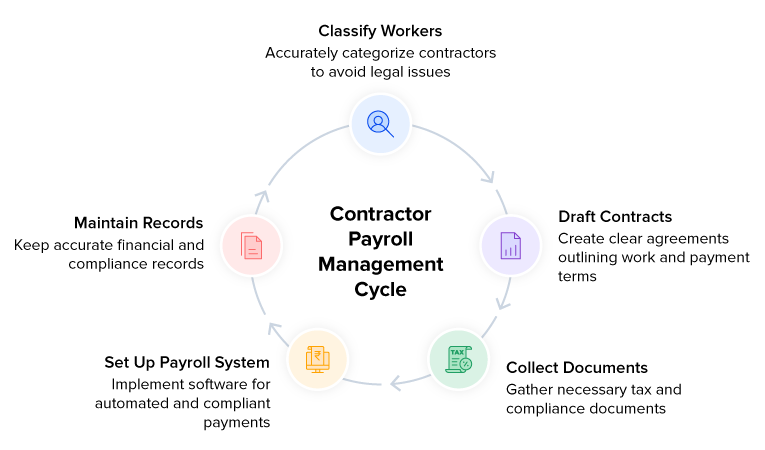How to Manage Contractor Payroll?

Table of Contents
Sometimes, organizations hire workers for a short-term project or when they need workers with specialized skills. Organizations need to hire workers with skills in the tech and services industry and manage contractor payroll at a lower cost in India. These freelance payroll processing trends are particularly crucial as contract workforce regulations evolve in 2026, and businesses seek to maintain efficient and compliant operations. Some companies misclassify contractors as employees, which can result in unwanted legal risks and penalties. Understanding local laws and regulations can be a challenge for businesses in India.
Currently, half of the global workforce (3.63 billion or 363 crores) is involved in freelancing or as independent contractors, either part-time or full-time. Following this trend, businesses are preferring independent contractors for various reasons. However, organizations find it challenging to implement and manage payroll for contract employees in India. This article explains how to manage contractor payroll and provides guidance on best compliance practices for organizations.
Understanding Contractor Payroll
Contractor payroll is the process of paying independent contractors by contractual agreements and ensuring compliance with current contractor payroll regulations and updated contract labor laws, including those effective as of 2026. It refers to the specialized process of managing and compensating independent contractors or temporary workers for their services. The company (contractee) hires a contractor for a short duration to perform a specific task or a project. This process is different from traditional employee payroll processing due to tax obligations and legal requirements.
Differentiating between full-time employees and contract employees will help companies manage payroll accounting smoothly. Clear independent contractor vs. employee classification helps avoid compliance risks, especially regarding PF and ESI applicability in India, as well as accurate TDS for contractors in India. Here are the key differences:
- Duration of Engagement: Contractors are typically hired for a short period to perform a specific task or project, whereas full-time employees are employed for the long term.
- Tax and Statutory Requirements: Companies are generally not responsible for withholding taxes from contract employees. On the other side, companies are responsible for statutory deductions for full-time employees.
- Payroll System Integration: Contract employees are not integrated into the payroll system for full-time employees because their payment schedules are variable. Full-time employees receive a regular salary, including benefits and allowances.

What is the Difference Between Contractor Payroll and Employee Payroll?
Organizations are often confused about the difference between contractor payroll and employee payroll. The primary difference lies in how payments are managed and the nature of the working relationship. Here are a few key differences to help understand the topic.
| Aspect | Contractor Payroll | Employee Payroll |
|---|---|---|
| Employment Relationship | An employee is introduced into the organization and is typically hired for the long term. | Fixed-term or project-based, where the contractor works independently. |
| Payment Structure | Payment is scheduled on a regular basis (monthly/weekly), which also includes bonuses and benefits. | Payment is through invoices or project completion, and does not include bonuses or benefits. |
| Tax Withholding | Employer deducts and remits income tax and other statutory taxes. | The employer deducts no tax, and the contractor handles their own tax filings. |
| Benefits | Includes employee benefits, like paid leave, health insurance, and retirement. | Benefits are not covered. |
| Equipment & Resources | The employer provides and pays on behalf of employees. | The contractor supplies their equipment/resources for which the cost is added to the invoice. |
| Training & Supervision | The employer provides training and controls how the work is done. | The contractor is responsible for their own training and control methods. |
| Payroll Compliance | Accurate payroll records and tax filings are required according to law. | Not covered by most labor laws. |

Key Steps to Manage Payroll for Contract Employees

Correctly Classify Workers
Classifying contractors as employees or vice versa can cause legal issues and payroll complications. Therefore, accurate classification will save unwanted expenses. Here are the pointers to keep in mind
Distinguish Between Employees and Contractors Using Local Guidelines
Companies need to differentiate between employees and contractors. For example, a company classifies an employee as an independent worker. As a result, the company fails to deduct taxes and contribute to PF/ESI.
Risks of Misclassification
Misidentifying the role can lead to legal actions and financial penalties. For example, a contractor is misclassified as an employee with a pay of ₹1,00,000/month. The penalty incurred from the back taxes would range from a few lakhs per year.
Use Checklists or Calculators for Accurate Classification
Checklists will establish clear differentiation and help avoid unnecessary confusion and mistakes. Organizations can ensure that contracts are accurate and transparent.
Draft Clear Contractual Agreements
Outline the Scope of Work
Concise and straightforward contractual agreements will allow both parties to work together effectively. The contractual agreements include work responsibilities, payment schedules, deadlines, payment structures, and other terms and conditions.
Specify Contractor Status, Rates, Invoicing, and Compliance with Local Laws
To minimize the company’s liability, organizations should specify accurate rates and establish a clear invoicing schedule for timely payments. All the terms and conditions should be in line with the local laws of the government.
Sign Contracts before Work Begins to Protect both Parties
Reading the contracts is essential before signing to start the project. Both parties can make necessary changes to the agreement as needed.
Collect Relevant Tax and Compliance Documents
- Collecting relevant tax documents from contractors is important before disbursing payments to ensure payroll compliance. These documents help in compliance and simplify tax reporting.
Set up a Streamlined Payroll System
Use Specialized Contractor Payroll Software
Selecting the best payroll software in India designed for contractor management can be beneficial due to its features. The functionalities include automated tax calculations and support for multiple currencies. Organizations can also customize payment schedules and provide an employee self-service portal to contractors to manage their data. The software should also help track work hours and maintain compliance from a centralized dashboard. Real-time data insights and data encryption measures should be included in the payroll software.
Automate Payment Schedules
The selected payroll software should include automated payment schedules for timely and accurate payments to contractors. The software can simplify some routine tasks and reduce the time spent on manual data entry. Organizations can integrate payroll software with accounting and attendance systems for data consistency. The software helps reduce overall costs and increase contractor satisfaction.
Maintain Accurate Records
Payroll software for contractors ensures data consistency and accuracy, which helps organizations with effective compliance management. Accurate data records can help avoid disputes, as all the invoices and transactions are tracked securely. Along with financial management, regular audits are conducted to find errors and take corrective actions.

Best Practices for Efficient Payroll Management for Contract Employees
The best practices for managing payroll for contract employees include a few strategic approaches that can enhance compliance, contractor satisfaction, and overall efficiency.
- Partner with Staffing Agencies: Partnering with EOR services for contractors can simplify compliance across multiple countries and reduce manual errors.
- Centralize Contractor Data: To manage contractor payroll effectively, organizations can consolidate contracts, tax documents, and payment records in a single, centralized location. This saves time during audits or performance reviews.
- Automate Repetitive Tasks: Automate repetitive tasks and use multi-country payroll compliance tools to address cross-border payment solutions seamlessly.
- Clear Communication Channels: To enhance transparency, it is recommended that contractors be provided with access to critical HR contact information and FAQs for ongoing support.
- Review and Update Regularly: The contract templates should be reviewed regularly, including payment terms and classifications, to account for changes in labor laws.
Common Challenges in Contractor Payroll
Among the most common challenges are complying with regulations governing contract workforce management and addressing international issues. Businesses struggle to manage contractor payroll and maintain compliance amid frequent payroll audits for contractors’ requirements.
- Multi-Country Regulations: Different regions have unique tax and labor laws, making it difficult for global companies to stay updated.
- Currency and Payment Delays: Companies often require currency conversions and fund transfers, which can lead to payment delays.
- Volume Management: When an organization expands, its contractor headcount increases. The tracking of contractors makes tracking of contracts difficult.
- Classification Risks: Misidentifying employee types can result in legal penalties and reputational damage.
- Dispute Resolution: Misunderstandings related to payment timelines or expectations can degrade the relationship with contractors.
Conclusion
Organizations that manage contractor payroll efficiently are more than just about timely payments. It protects the company from legal risks, improves relationships with contractors, and supports scalable growth. The solution is accurate classification, clear contracts, document compliance, and the right software.
Companies should ensure that their contracts are regularly updated and aligned with local laws to avoid potential legal consequences. With the proper practices and tools in place, businesses can manage contractor payroll effectively, as it is beneficial for multiple reasons.

FAQ
What is Contractor Payroll Management?
Contractor payroll management refers to the process of paying independent contractors or businesses that provide services to a company on a project basis. When compared to traditional employee payroll, contractor payroll includes specific terms and conditions on payment structures and compliance with laws.
How do I Determine whether Workers are Classified as Contractors or Employees?
To determine whether a worker should be classified as a contractor or an employee, organizations need to assess the level of control and independence in the working relationship. Employees have a high degree of control and direction from their employer, and are hired for an extended period. Contractors operate independently and control how they work. Employees typically receive benefits, whereas contractors generally do not.
What Information do I Need from Global Contractors to Process Payroll?
To process payroll for contractors, organizations need their completed W-9 form. This form provides the contractor’s taxpayer identification number (TIN) and other necessary tax-related information. Other details, including rates and any tax implications, need to be determined to process payroll.
How do I Ensure Compliance with Tax Laws when Managing Contractor Payroll?
To ensure compliance with tax laws and manage contractor payroll, several steps must be followed.
- Accurate Classification of Contractors
- Understand Tax Obligations (National and State Taxes)
- Maintain Formal Contracts and Agreements
- Utilize payroll software for automation
- Stay Updated on Laws and Regulations
What Documentation Should I Maintain for Contractor Payroll Management?
To manage contractor payroll, organizations should maintain the following documents.
- Contractor Agreement
- Labour License
- EPF and ESIC Coverage Letters
- Attendance Register / Muster Roll as CLRA Act requirements
- payment records, and avoid cash payments
- Tax Documentation
- Communications and Invoices
- Inspection Reports
How do You Pay International Contractors?
There are multiple methods through which organizations can pay international contractors. These are:
- Bank transfers (wire transfers)
- Digital payment platforms like PayPal, Payoneer, and Wise
What are the Risks of Contractor Misclassification?
These risks of contractor misclassification include:
- Financial Penalties and Liabilities, like fines
- Legal and Regulatory Consequences, like lawsuits
- Reputational Damage and Morale Impact
What is the Best Software for Contractor Payroll?
Some of the best software where businesses can manage contractor payroll is:
- factorHR
- Deel
- Remote
- Rippling
- Asanify
Grow your business with factoHR today
Focus on the significant decision-making tasks, transfer all your common repetitive HR tasks to factoHR and see the things falling into their place.

© 2026 Copyright factoHR


